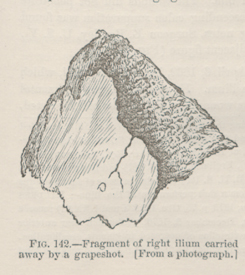Title: Gibson, W. J.
Source text: The Medical and Surgical History of the War of the Rebellion. (1861-65.), Part 2, Volume 2 (Washington, DC: Government Printing Office, 1876), 215.
Civil War Washington ID: med.d2e31879
TEI/XML: med.d2e31879.xml
CASE 629. Private W. J. Gibson, Co. G, 102d Pennsylvania, aged 20 years, was wounded at the Wilderness, May 5, 1864, by a six-ounce grapeshot, which entered the front of the abdomen a little below a line drawn from the umbilicus to the anterior superior spinous process, and about three inches from the border of the right ilium, and passed through the middle of the ilium, carrying before it a portion of the bone more than two inches square; both the ball and the fragment of bone lodged in the gluteal muscles. He was removed to the field hospital of the 2d division, Sixth Corps, where Surgeon George F. Stevens, 77th New York administered chloroform, and removed, through an extensive incision along the nates, the missile and the fragment of bone which lay in proximity. The borders of the large opening in the ilium were smoothed by means of the bone forceps somewhat enlarging the orifice. The wound was then brought together, and water-dressings applied. He passed through the hard experience of the wounded of the Wilderness, being drawn in an army wagon two nights and a day over rough roads, and for several days received little or no care. [The above notes of the case appear on a special report furnished by the operator.] On May 25th, the patient was removed to Lincoln Hospital, Washington>, and on July 28th, to the hospital at Pittsburg, where he was transferred to the Veteran Reserve Corps, January 30, 1865. He was discharged June 19, 1865, and pensioned. Examining Surgeon D. N. Rankin, of Alleghany City, reported, July 5, 1865, that "the missile entered the right iliac region and fractured the right ilium. Great deformity of the parts and a partial loss of the use of the right leg resulted. He has had poor health since the reception of the injury." This pensioner died October 7, 1866. Dr. Stevens had prepared and sent to the Museum a ferrotype of the specimens removed, which are represented, of the size of nature, in the adjacent drawings (FIGS. 142 and 143).

